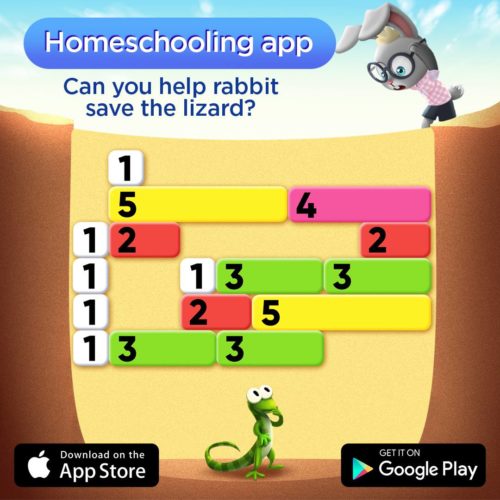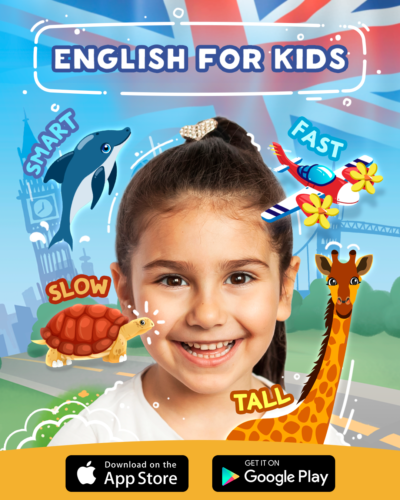Anastasia Pavlovskaya, creative manager of the IntellectoKids studio, which is engaged in the creation of children’s educational applications, shares her experience in creating creatives for mobile products
Anastasia Pavlovskaya
How it all started in IntellectoKids
There was a time when we at IntellectoKids outsourced creative processes. Unfortunately, we have a bad experience working with agencies. There are two reasons for this.
First. The sphere of children’s applications in which we work is specific, the techniques that are used in advertising, say, mobile games, are often not suitable here. It is important for us to show the educational value of the product, and for this it is necessary to understand the audience of parents very well.
Second. Children’s applications are a niche area, so many agencies do not have enough experience in promoting such projects, there is no data to work with our target audience.
Because of all this, we decided to create something like an inhouse agency for the development of creatives.
A year and a half ago, when I joined the company, my main task in the first months was to form a creative team and streamline processes.
Stages of the creative process
I’ll make a reservation right away: creativity has little to do with creativity, especially if you mean sudden insights by creativity. It has nothing to do with inspiration either. Creative ideas are not born out of thin air.
Creativity is a systematized process that can be decomposed into various methodologies, even described in a textbook (take, for example, Edward De Bono‘s books about Lateral Thinking).
However, the creators do not always have time to use special techniques. But if you choose a creative team correctly and adhere to at least the minimum rules, you can achieve good results.
We succeeded in this.
Now to the processes that we have built. Today, our work on creatives consists of three stages:
- The big brainstorm that we hold at the beginning of each month. On it, we share hypotheses and ideas, choose the best ones.
- Call once a week. On it, we form a pool of tasks: what needs to be drawn, which video to launch, and so on.
- Demo at the end of the month. This is a classic team synchronization tool, on which we reflect on what we did, what did not work out, which creatives were the most successful, and which ones should be “screwed up”, what and how could be improved.
In this post, I will focus on how we conduct a brainstorm, because it is during it that we generate ideas and suggestions regarding creatives.
Rules and stages of brainstorm sessions
The main thing for brainstorm is the presence of a team. Ideally, it should be cross-functional.
In our case , the team includes:
- 2 creative managers;
- 2 graphic designers;
- motion-designer;
- copywriter;
- UA manager.
It is good if people of different psychotypes are selected, for example:
- a good organizer who will take over the brainstorm;
- generator — such a person usually gives out a large number of very different ideas in a short time;
- a critic is a participant who constantly analyzes every idea from all sides and identifies risks and disadvantages. It is indispensable at the filtration stage;
- optimist — will find strengths in all ideas;
- an informant who will return you to the starting point at the stage of generating ideas and tell you what additional information is needed to create a specific idea, where to find this information and how to use it;
- an intuit is a person who can evaluate an idea on an emotional level. At a certain stage of the brainstorm, you can all try to become intuitives together and discuss the idea in terms of the emotions that it causes.
You can change roles and give each participant a turn to speak out, who will take on the role of a specific psychotype. Read more about this approach from Edward De Bono (The 6 Hats Method).
We periodically hold a brainstorm like this: everyone prepares one idea on a given topic, shares it, and then the others take turns “throwing” something of their own on this idea. So one idea turns out to be several.
Since we have a distributed team, we use Miro to record hypotheses and ideas. But you can also fix ideas on a marker board or glue stickers on the board.
A special type of brainstorm is the so—called “quiet”, when participants do not speak out, but anonymously write their thoughts on pieces of paper. Then the presenter collects all the ideas and reads them out. The method is suitable for introverted teams.
As for the stages, we have brainstorms according to the following algorithm:
- a) preparation;
- b) hypothesis generation;
- c) generating ideas;
- d) filtering of ideas.
It should be remembered that at no stage of the brainstorm can you interrupt each other.
I will tell you more about each step.
a) Preparation
In an ideal world, participants come to brainstorm — and immediately begin to animatedly give out ideas one after another. But this is in an ideal world, but in reality everything is usually different: at first everyone is clamped, shy and not “burning” with the process, they can’t immediately come up with anything new. This is absolutely normal, you need to tune in to the creative process. The task of the presenter is to wake people up to the main part of the brainstorming.
We have a brainstorm theme formulated in advance, so everyone comes already with sketches of ideas. We often start with a relaxed conversation on abstract topics to defuse the atmosphere. And we also watch various commercials.
If the brainstorm is tight, you can give the team members a simple exercise to swing. For example, ask participants to write as many different, including unusual, associations to a word as possible.
b) Generation of hypotheses and ideas
The main thing to remember is that any criticism, even the most tactful and constructive, is unacceptable at these two stages. Your team members should feel liberated.
Now let’s understand the terminology. It’s easy to distinguish a hypothesis from an idea. A hypothesis is an assumption about how the target audience thinks and what they want from the product.
I will explain by the example of the audience of parents of a children’s educational application.
Let’s say you decide: the parent wants him not to have to persuade the child to study. This is your hypothesis. Then, on its basis, a communication message should be compiled. In your case, it will be something like “Playing, the child will not notice how he will get new skills.” And only then, based on a hypothesis and a message, you can come up with an idea, packing it into some visual and textual content.
In short, a hypothesis is what we want to convey, and an idea is how we want to do it.
When I first came to work at the company, I created a large document — a matrix of hypotheses and ideas. I wrote out all the benefits of our application IntellectoKids Learning Games, the main pains and needs of the target audience — and tried to correlate them with each other by grouping. Without this, it would be very difficult to do anything further. Our first TK was the result of this work.
Where to get hypotheses and ideas?
The first source, of course, is your audience. Custdev should be performed as often as possible to identify her main pains.
You can also follow the audience in corporate social networks: posts on which topic are most popular, what comments are left by users?
For example, thanks to this method, we discovered that parents are concerned about how quickly and well a child will learn to count, and we use creatives related to this problem.
The second source is competitors. Conduct a competitive analysis and evaluate the strengths and weaknesses of other market players. This will allow you to find opportunities to improve your competitive advantage and rebuild with your communication. But don’t get carried away, sometimes one or another approach is not used by your competitors for a reason.
Third, research trends carefully. Facebook Instagrammers study the news agenda, use Google Trends, and monitor the appearance of memes and new challenges on Instagram and Facebook.
For example, during the pandemic, when children were quarantined, we made a simple creative with the inscription: “Homeschooling App”. And he gave us a large number of installations.
Finally, the last source is advertising networks that, like you, are interested in making your advertising effective.
When we launch into new markets, we seek the advice of neytivs to discuss which advertising is popular in the country, as well as to search for cultural codes that can be applied. We are often told things that we would not have known about ourselves. For example, that advertising images of European children are more in demand in Japan than Asian ones.
The “5 why” method is well suited for the formulation of hypotheses: you ask brainstorm participants five questions about the needs of the target audience. Participants are trying to find answers.
For example:
– Why does mom want the child to learn to count?
– To get him ready for school.
– Why is it so important for a mother to prepare a child for school?
– So that he gets good grades.
Etc.
As a result, each subsequent response affects the pain of the CA more deeply.
You can also model the questions that potential users can ask your product. This is necessary in order to show in advertising exactly what the audience needs.
There are many more special techniques for coming up with ideas.
c) Filtering of ideas
It’s time to let the inner critic out! Filtering of ideas is necessary, as you might guess, in order to weed out controversial proposals and leave the best practices.
To filter out ideas, you need to, figuratively speaking, sift them through a sieve of the conditions of your task. We check the idea for compliance with several points.
- Originality. You have a couple of seconds for the user’s gaze to catch on to the advertisement of your application. To do this, your creative must at least be unusual. In particular, we are looking at whether we have done such advertising before and whether competitors have done something similar.
- Realizability and speed of creation. If an idea requires a long complex production, it should be simplified or postponed until the company has resources.
- A match with a hypothesis and a communication message. Otherwise, why did we do all this, really, if we didn’t take into account the needs of the target audience?
- There is nothing in the creative from the list of your restrictions. Restrictions are something that you cannot use in advertising under any circumstances. For example, copyright is on the verge of a foul. For example, we will never show in the creative how the child is sitting in the tablet, and the mother is drinking coffee at this time. Because such advertising causes a parent not to want to buy a subscription to our product, but a sense of guilt.
- The age of the target audience. We are developing educational apps for children up to 7 years old. Therefore, it would be strange to promise parents in advertising that we will teach their child to solve quadratic equations.
What could happen next?
Imagine that you chose an idea, launched an advertisement on it, but it did not bring you new installations. The easiest way is to abandon it. But there is another one: to test changes in the creative.
We had a case when we managed to significantly reduce the CPI and increase the CTR of the creative by 3 times due to the fact that we did not reject the idea when it went badly, but refined it in several iterations.
To save time when testing creatives, we use a method that can be called a constructor for convenience. If we are testing a new hypothesis in a video, we don’t have to create the entire 15-second video from scratch, since we have prepared video blocks. It is enough to place a new hypothesis in the first 5 seconds, and take the packshot and the middle part from the blanks. If we see that the hypothesis has hooked our audience, we refine the middle part and the packshot. And then we are already testing changes in the creative itself.
What’s next?
The brainstorm has come to an end, you have chosen the best ideas to implement, and the rest… And really, what to do with the rest? We carefully store all our ideas and periodically return to them. We advise you to create a special folder or document so as not to lose anything. One day an old forgotten idea may shoot out — and you will be grateful to yourself.





